NURS 11160 Clinical Nursing: A Detailed Report on Patient Mr. Sharman
VerifiedAdded on 2023/06/09
|16
|3266
|379
Report
AI Summary
This report details the clinical nursing practice involved in the care of Mr. Sharman, a patient recovering from a cerebrovascular accident. It covers essential nursing interventions such as hand hygiene, fall risk assessment, and safe patient transfer. The report includes a Q-ADDS score calculation to monitor the patient's deteriorating condition and outlines the steps for conducting a urinalysis with appropriate PPE. Effective communication using the ISBAR framework is demonstrated, ensuring clear and concise information exchange with the healthcare team. The document also references the importance of clinical handover in patient care. The supplementary assessment focuses on patient assessment and PPE, fluid balance charts, vital signs and professional communication.
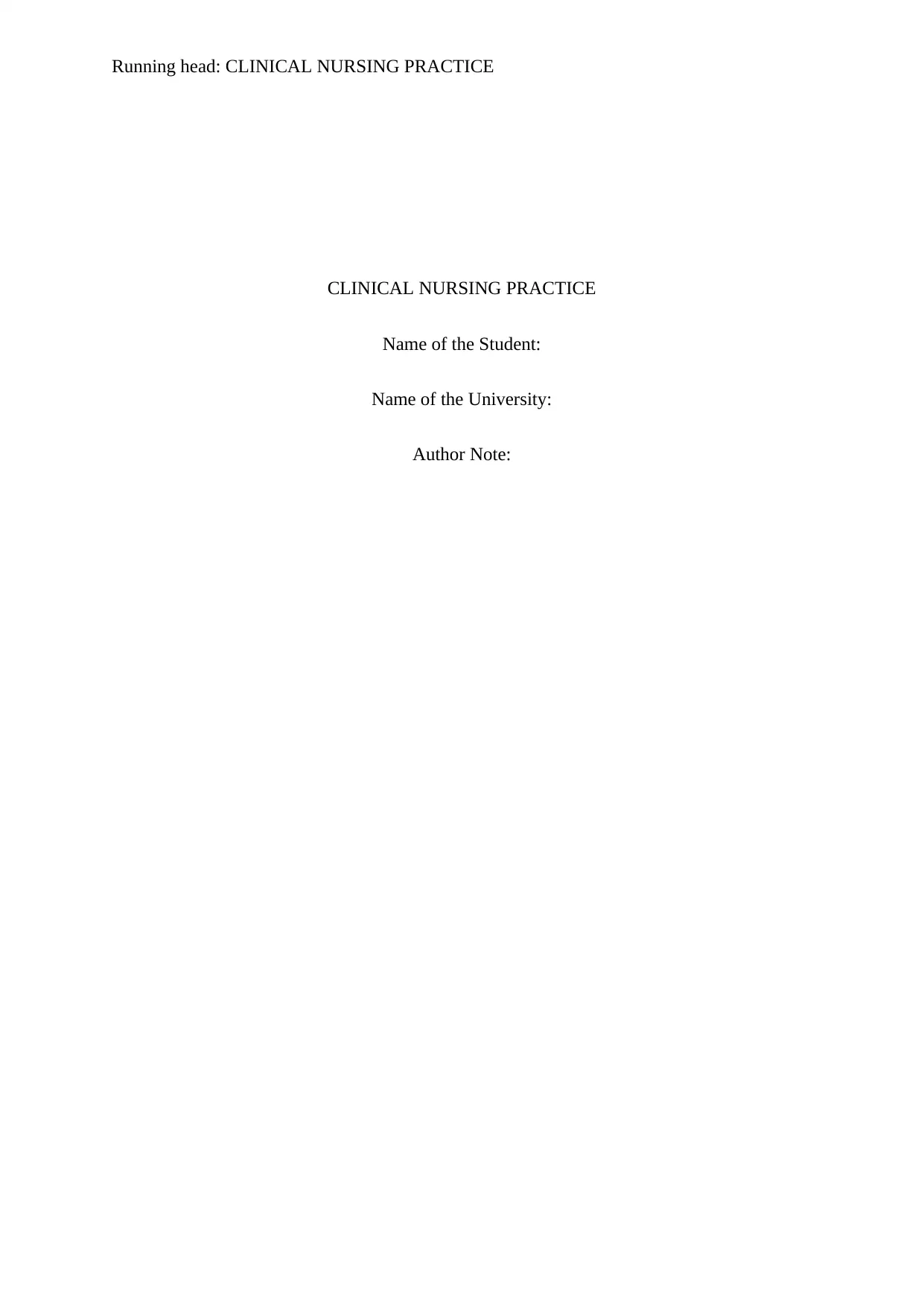
Running head: CLINICAL NURSING PRACTICE
CLINICAL NURSING PRACTICE
Name of the Student:
Name of the University:
Author Note:
CLINICAL NURSING PRACTICE
Name of the Student:
Name of the University:
Author Note:
Paraphrase This Document
Need a fresh take? Get an instant paraphrase of this document with our AI Paraphraser
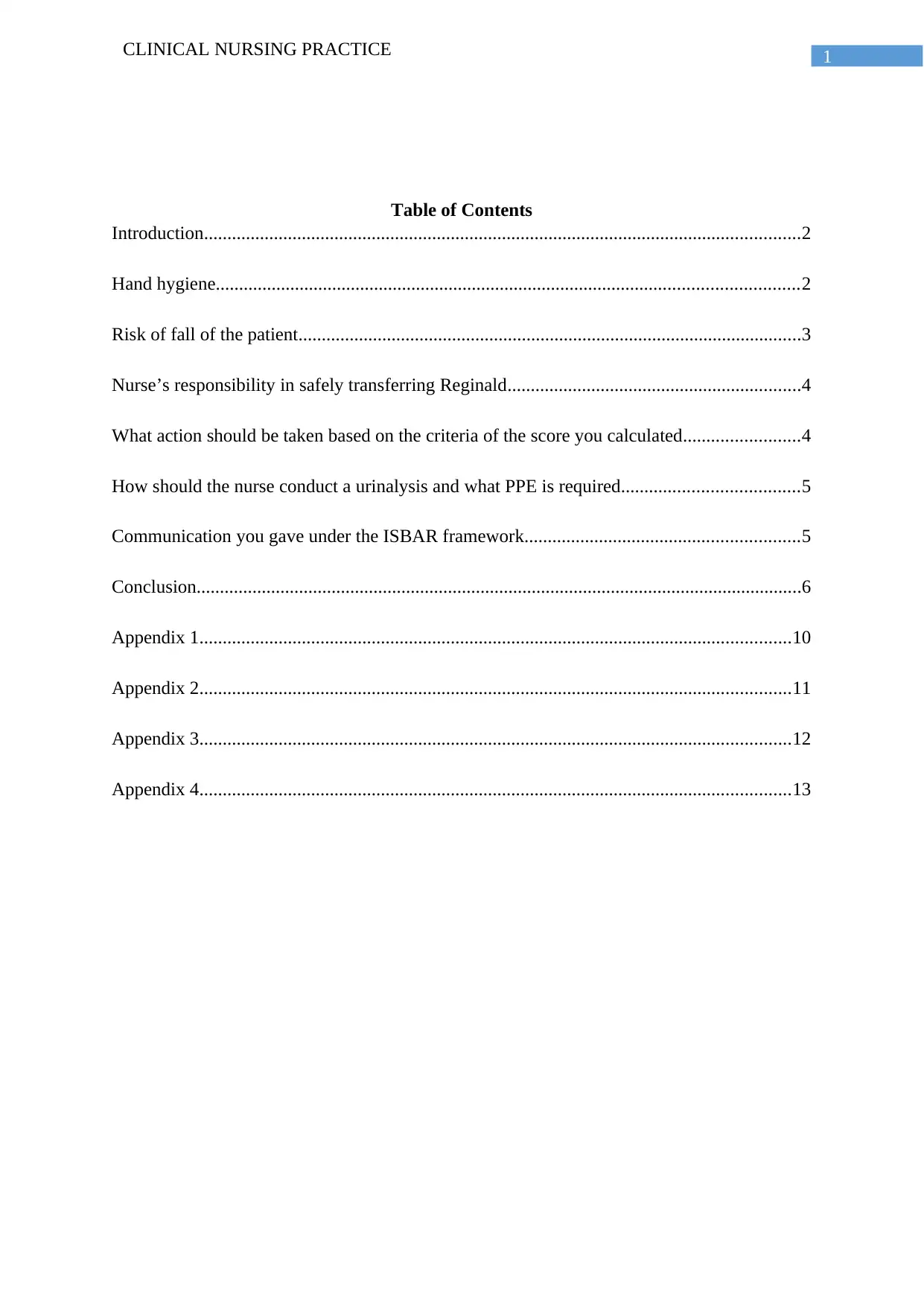
1CLINICAL NURSING PRACTICE
Table of Contents
Introduction................................................................................................................................2
Hand hygiene.............................................................................................................................2
Risk of fall of the patient............................................................................................................3
Nurse’s responsibility in safely transferring Reginald...............................................................4
What action should be taken based on the criteria of the score you calculated.........................4
How should the nurse conduct a urinalysis and what PPE is required......................................5
Communication you gave under the ISBAR framework...........................................................5
Conclusion..................................................................................................................................6
Appendix 1...............................................................................................................................10
Appendix 2...............................................................................................................................11
Appendix 3...............................................................................................................................12
Appendix 4...............................................................................................................................13
Table of Contents
Introduction................................................................................................................................2
Hand hygiene.............................................................................................................................2
Risk of fall of the patient............................................................................................................3
Nurse’s responsibility in safely transferring Reginald...............................................................4
What action should be taken based on the criteria of the score you calculated.........................4
How should the nurse conduct a urinalysis and what PPE is required......................................5
Communication you gave under the ISBAR framework...........................................................5
Conclusion..................................................................................................................................6
Appendix 1...............................................................................................................................10
Appendix 2...............................................................................................................................11
Appendix 3...............................................................................................................................12
Appendix 4...............................................................................................................................13

2CLINICAL NURSING PRACTICE
Introduction
The practise of nursing involves activities that help in facilitating the patients in
receiving improved quality of health care. There is a constant effort shown by the Nursing
and Midwifery Board of Australia (NMBA) to effectively manage and guide the nurses in
their practice. The paper reflects nursing interventions that are required for provision of
proper care to patients especially in the emergency wards. It discusses the hand hygiene
interventions, involving the 5 moments of hand hygiene. Additionally the paper reports
regarding the vitals status of the patient Mr. Sharman and shows his Q-ADD score along with
his progress report. The aim of this report is to highlight the conditions of the patient Mr.
Sharman who is under rehabilitation and illustrate the nature of care that is provided to him.
The report also puts forward the various documentations that are involved in provision of
care of the patient Mr. Sharman which entails all the information regarding him. This details
help to influence the clinical practise that is provided by the health personnel.
Clinical handover refers to the process of transfer of the patient from one particular
team to another, along with the transfer of the patient’s responsibilities and the
accountability. It also refers to the patient’s information communication process (Sujan et al.,
2014). It aims to mentor the staff members who are juniors, providing them with a platform
for group cohesion. The elements of clinical handover includes teaching and training of the
staff members. It also provides opportunities to the newcomers of the field to interact with the
medical culture. Situational analysis is one major part of clinical handover. The situations are
needed to be interpreted, which can be conducted in different levels. The first level refers to
perceiving the critical factors that exists in the environment. The factors which exists needs to
be properly understood and comprehended and finally the happenings of the future could be
predicted through situational analysis. This can be related to Standard 6 that is
Introduction
The practise of nursing involves activities that help in facilitating the patients in
receiving improved quality of health care. There is a constant effort shown by the Nursing
and Midwifery Board of Australia (NMBA) to effectively manage and guide the nurses in
their practice. The paper reflects nursing interventions that are required for provision of
proper care to patients especially in the emergency wards. It discusses the hand hygiene
interventions, involving the 5 moments of hand hygiene. Additionally the paper reports
regarding the vitals status of the patient Mr. Sharman and shows his Q-ADD score along with
his progress report. The aim of this report is to highlight the conditions of the patient Mr.
Sharman who is under rehabilitation and illustrate the nature of care that is provided to him.
The report also puts forward the various documentations that are involved in provision of
care of the patient Mr. Sharman which entails all the information regarding him. This details
help to influence the clinical practise that is provided by the health personnel.
Clinical handover refers to the process of transfer of the patient from one particular
team to another, along with the transfer of the patient’s responsibilities and the
accountability. It also refers to the patient’s information communication process (Sujan et al.,
2014). It aims to mentor the staff members who are juniors, providing them with a platform
for group cohesion. The elements of clinical handover includes teaching and training of the
staff members. It also provides opportunities to the newcomers of the field to interact with the
medical culture. Situational analysis is one major part of clinical handover. The situations are
needed to be interpreted, which can be conducted in different levels. The first level refers to
perceiving the critical factors that exists in the environment. The factors which exists needs to
be properly understood and comprehended and finally the happenings of the future could be
predicted through situational analysis. This can be related to Standard 6 that is
⊘ This is a preview!⊘
Do you want full access?
Subscribe today to unlock all pages.

Trusted by 1+ million students worldwide
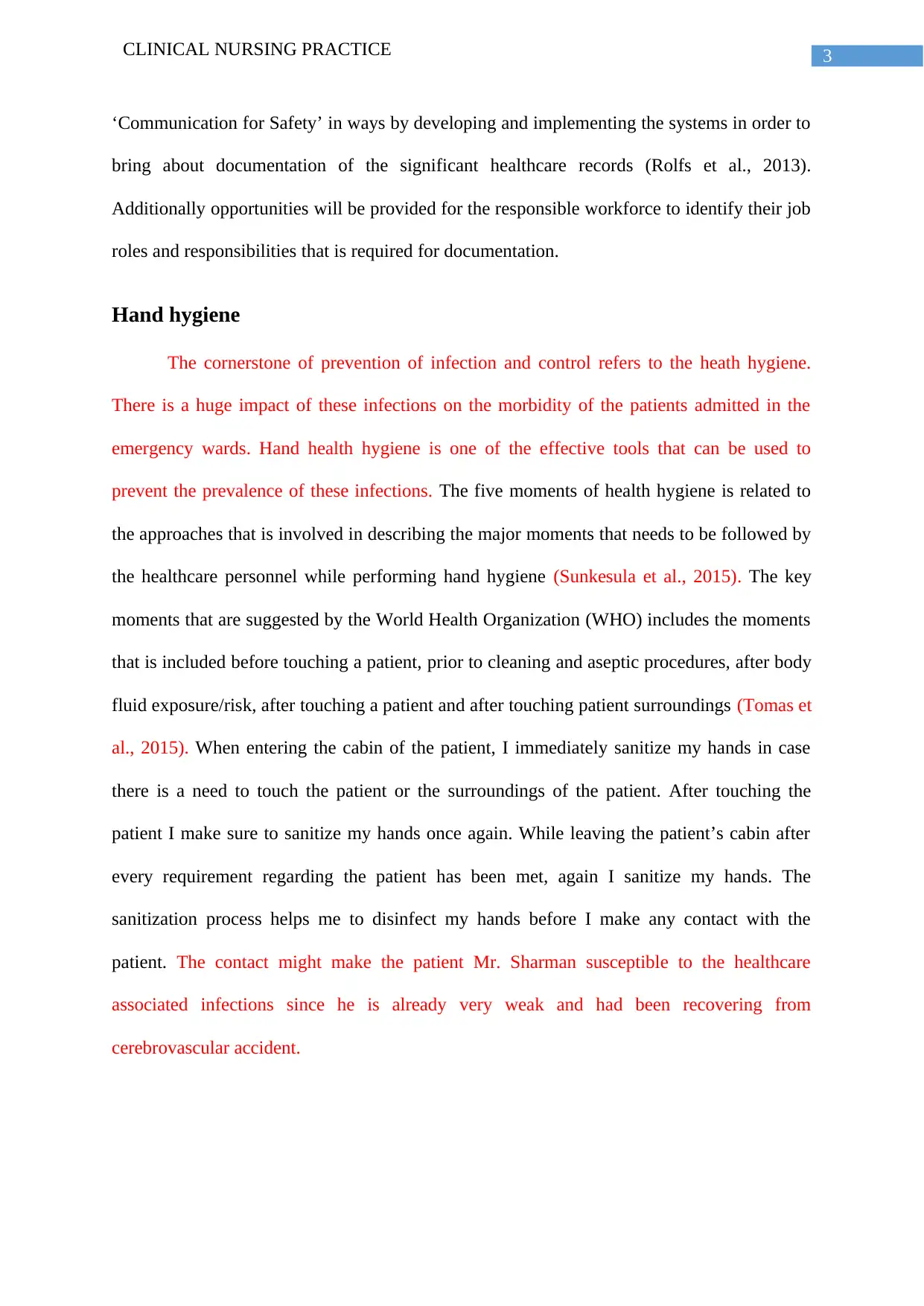
3CLINICAL NURSING PRACTICE
‘Communication for Safety’ in ways by developing and implementing the systems in order to
bring about documentation of the significant healthcare records (Rolfs et al., 2013).
Additionally opportunities will be provided for the responsible workforce to identify their job
roles and responsibilities that is required for documentation.
Hand hygiene
The cornerstone of prevention of infection and control refers to the heath hygiene.
There is a huge impact of these infections on the morbidity of the patients admitted in the
emergency wards. Hand health hygiene is one of the effective tools that can be used to
prevent the prevalence of these infections. The five moments of health hygiene is related to
the approaches that is involved in describing the major moments that needs to be followed by
the healthcare personnel while performing hand hygiene (Sunkesula et al., 2015). The key
moments that are suggested by the World Health Organization (WHO) includes the moments
that is included before touching a patient, prior to cleaning and aseptic procedures, after body
fluid exposure/risk, after touching a patient and after touching patient surroundings (Tomas et
al., 2015). When entering the cabin of the patient, I immediately sanitize my hands in case
there is a need to touch the patient or the surroundings of the patient. After touching the
patient I make sure to sanitize my hands once again. While leaving the patient’s cabin after
every requirement regarding the patient has been met, again I sanitize my hands. The
sanitization process helps me to disinfect my hands before I make any contact with the
patient. The contact might make the patient Mr. Sharman susceptible to the healthcare
associated infections since he is already very weak and had been recovering from
cerebrovascular accident.
‘Communication for Safety’ in ways by developing and implementing the systems in order to
bring about documentation of the significant healthcare records (Rolfs et al., 2013).
Additionally opportunities will be provided for the responsible workforce to identify their job
roles and responsibilities that is required for documentation.
Hand hygiene
The cornerstone of prevention of infection and control refers to the heath hygiene.
There is a huge impact of these infections on the morbidity of the patients admitted in the
emergency wards. Hand health hygiene is one of the effective tools that can be used to
prevent the prevalence of these infections. The five moments of health hygiene is related to
the approaches that is involved in describing the major moments that needs to be followed by
the healthcare personnel while performing hand hygiene (Sunkesula et al., 2015). The key
moments that are suggested by the World Health Organization (WHO) includes the moments
that is included before touching a patient, prior to cleaning and aseptic procedures, after body
fluid exposure/risk, after touching a patient and after touching patient surroundings (Tomas et
al., 2015). When entering the cabin of the patient, I immediately sanitize my hands in case
there is a need to touch the patient or the surroundings of the patient. After touching the
patient I make sure to sanitize my hands once again. While leaving the patient’s cabin after
every requirement regarding the patient has been met, again I sanitize my hands. The
sanitization process helps me to disinfect my hands before I make any contact with the
patient. The contact might make the patient Mr. Sharman susceptible to the healthcare
associated infections since he is already very weak and had been recovering from
cerebrovascular accident.
Paraphrase This Document
Need a fresh take? Get an instant paraphrase of this document with our AI Paraphraser
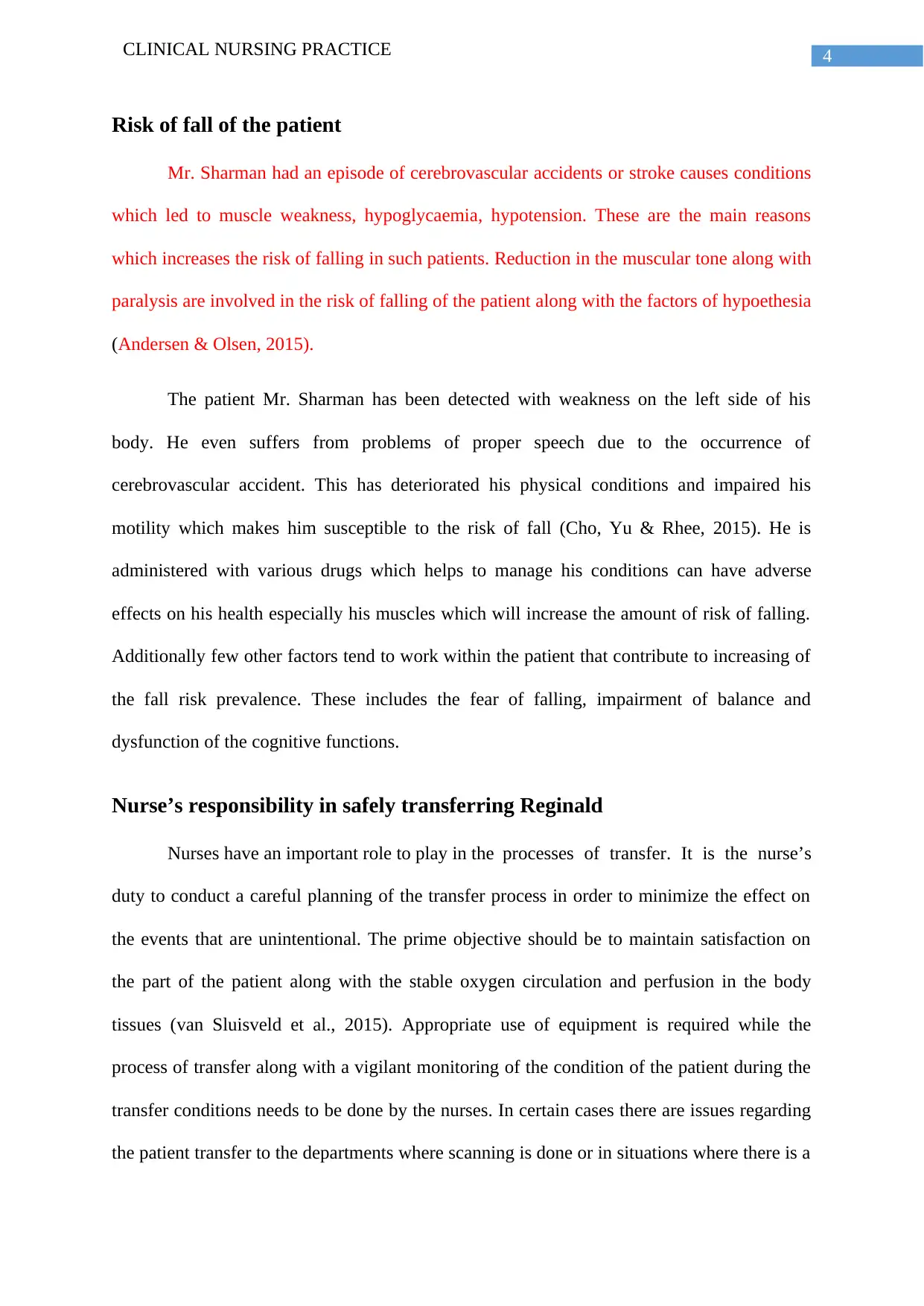
4CLINICAL NURSING PRACTICE
Risk of fall of the patient
Mr. Sharman had an episode of cerebrovascular accidents or stroke causes conditions
which led to muscle weakness, hypoglycaemia, hypotension. These are the main reasons
which increases the risk of falling in such patients. Reduction in the muscular tone along with
paralysis are involved in the risk of falling of the patient along with the factors of hypoethesia
(Andersen & Olsen, 2015).
The patient Mr. Sharman has been detected with weakness on the left side of his
body. He even suffers from problems of proper speech due to the occurrence of
cerebrovascular accident. This has deteriorated his physical conditions and impaired his
motility which makes him susceptible to the risk of fall (Cho, Yu & Rhee, 2015). He is
administered with various drugs which helps to manage his conditions can have adverse
effects on his health especially his muscles which will increase the amount of risk of falling.
Additionally few other factors tend to work within the patient that contribute to increasing of
the fall risk prevalence. These includes the fear of falling, impairment of balance and
dysfunction of the cognitive functions.
Nurse’s responsibility in safely transferring Reginald
Nurses have an important role to play in the processes of transfer. It is the nurse’s
duty to conduct a careful planning of the transfer process in order to minimize the effect on
the events that are unintentional. The prime objective should be to maintain satisfaction on
the part of the patient along with the stable oxygen circulation and perfusion in the body
tissues (van Sluisveld et al., 2015). Appropriate use of equipment is required while the
process of transfer along with a vigilant monitoring of the condition of the patient during the
transfer conditions needs to be done by the nurses. In certain cases there are issues regarding
the patient transfer to the departments where scanning is done or in situations where there is a
Risk of fall of the patient
Mr. Sharman had an episode of cerebrovascular accidents or stroke causes conditions
which led to muscle weakness, hypoglycaemia, hypotension. These are the main reasons
which increases the risk of falling in such patients. Reduction in the muscular tone along with
paralysis are involved in the risk of falling of the patient along with the factors of hypoethesia
(Andersen & Olsen, 2015).
The patient Mr. Sharman has been detected with weakness on the left side of his
body. He even suffers from problems of proper speech due to the occurrence of
cerebrovascular accident. This has deteriorated his physical conditions and impaired his
motility which makes him susceptible to the risk of fall (Cho, Yu & Rhee, 2015). He is
administered with various drugs which helps to manage his conditions can have adverse
effects on his health especially his muscles which will increase the amount of risk of falling.
Additionally few other factors tend to work within the patient that contribute to increasing of
the fall risk prevalence. These includes the fear of falling, impairment of balance and
dysfunction of the cognitive functions.
Nurse’s responsibility in safely transferring Reginald
Nurses have an important role to play in the processes of transfer. It is the nurse’s
duty to conduct a careful planning of the transfer process in order to minimize the effect on
the events that are unintentional. The prime objective should be to maintain satisfaction on
the part of the patient along with the stable oxygen circulation and perfusion in the body
tissues (van Sluisveld et al., 2015). Appropriate use of equipment is required while the
process of transfer along with a vigilant monitoring of the condition of the patient during the
transfer conditions needs to be done by the nurses. In certain cases there are issues regarding
the patient transfer to the departments where scanning is done or in situations where there is a
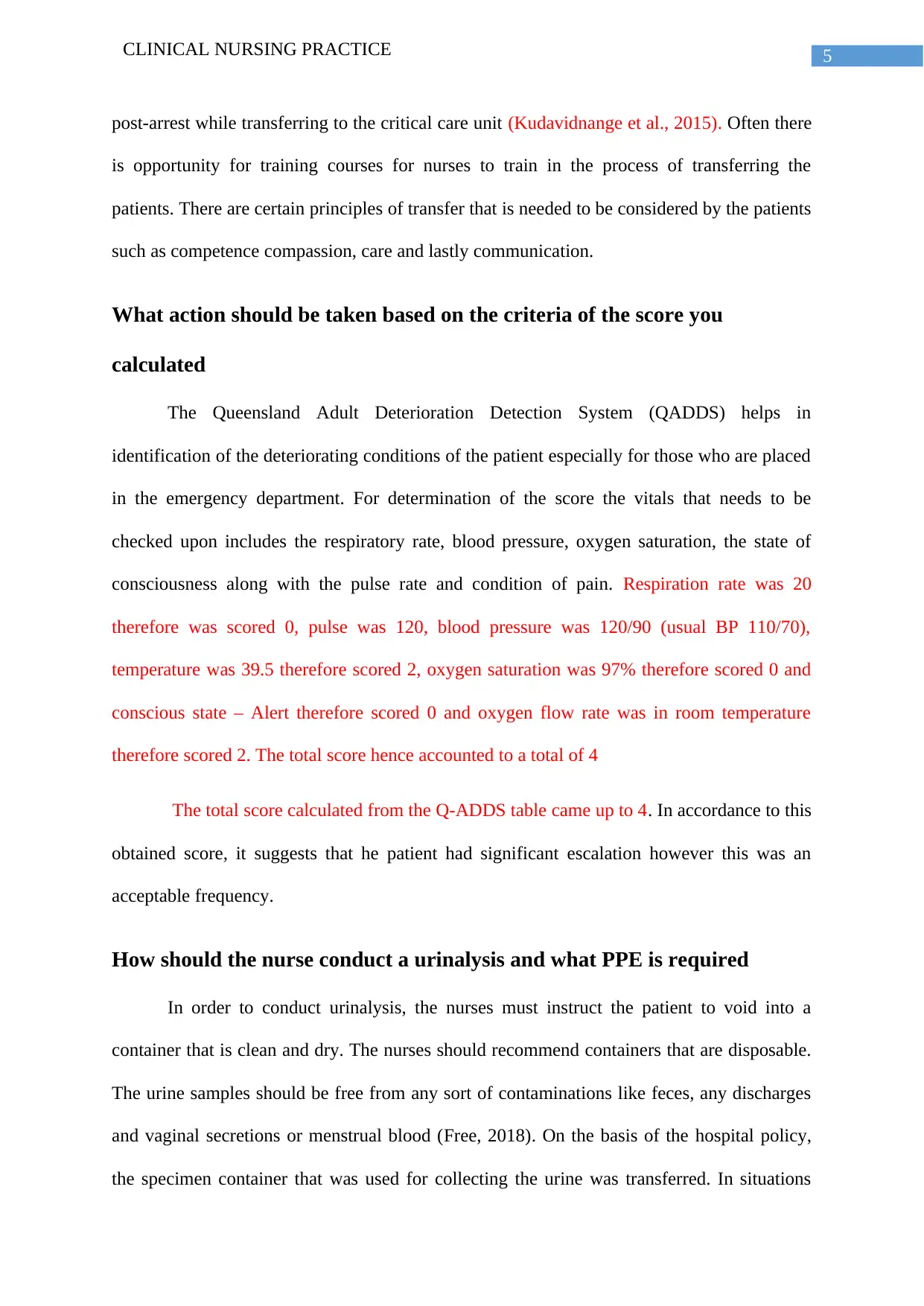
5CLINICAL NURSING PRACTICE
post-arrest while transferring to the critical care unit (Kudavidnange et al., 2015). Often there
is opportunity for training courses for nurses to train in the process of transferring the
patients. There are certain principles of transfer that is needed to be considered by the patients
such as competence compassion, care and lastly communication.
What action should be taken based on the criteria of the score you
calculated
The Queensland Adult Deterioration Detection System (QADDS) helps in
identification of the deteriorating conditions of the patient especially for those who are placed
in the emergency department. For determination of the score the vitals that needs to be
checked upon includes the respiratory rate, blood pressure, oxygen saturation, the state of
consciousness along with the pulse rate and condition of pain. Respiration rate was 20
therefore was scored 0, pulse was 120, blood pressure was 120/90 (usual BP 110/70),
temperature was 39.5 therefore scored 2, oxygen saturation was 97% therefore scored 0 and
conscious state – Alert therefore scored 0 and oxygen flow rate was in room temperature
therefore scored 2. The total score hence accounted to a total of 4
The total score calculated from the Q-ADDS table came up to 4. In accordance to this
obtained score, it suggests that he patient had significant escalation however this was an
acceptable frequency.
How should the nurse conduct a urinalysis and what PPE is required
In order to conduct urinalysis, the nurses must instruct the patient to void into a
container that is clean and dry. The nurses should recommend containers that are disposable.
The urine samples should be free from any sort of contaminations like feces, any discharges
and vaginal secretions or menstrual blood (Free, 2018). On the basis of the hospital policy,
the specimen container that was used for collecting the urine was transferred. In situations
post-arrest while transferring to the critical care unit (Kudavidnange et al., 2015). Often there
is opportunity for training courses for nurses to train in the process of transferring the
patients. There are certain principles of transfer that is needed to be considered by the patients
such as competence compassion, care and lastly communication.
What action should be taken based on the criteria of the score you
calculated
The Queensland Adult Deterioration Detection System (QADDS) helps in
identification of the deteriorating conditions of the patient especially for those who are placed
in the emergency department. For determination of the score the vitals that needs to be
checked upon includes the respiratory rate, blood pressure, oxygen saturation, the state of
consciousness along with the pulse rate and condition of pain. Respiration rate was 20
therefore was scored 0, pulse was 120, blood pressure was 120/90 (usual BP 110/70),
temperature was 39.5 therefore scored 2, oxygen saturation was 97% therefore scored 0 and
conscious state – Alert therefore scored 0 and oxygen flow rate was in room temperature
therefore scored 2. The total score hence accounted to a total of 4
The total score calculated from the Q-ADDS table came up to 4. In accordance to this
obtained score, it suggests that he patient had significant escalation however this was an
acceptable frequency.
How should the nurse conduct a urinalysis and what PPE is required
In order to conduct urinalysis, the nurses must instruct the patient to void into a
container that is clean and dry. The nurses should recommend containers that are disposable.
The urine samples should be free from any sort of contaminations like feces, any discharges
and vaginal secretions or menstrual blood (Free, 2018). On the basis of the hospital policy,
the specimen container that was used for collecting the urine was transferred. In situations
⊘ This is a preview!⊘
Do you want full access?
Subscribe today to unlock all pages.

Trusted by 1+ million students worldwide
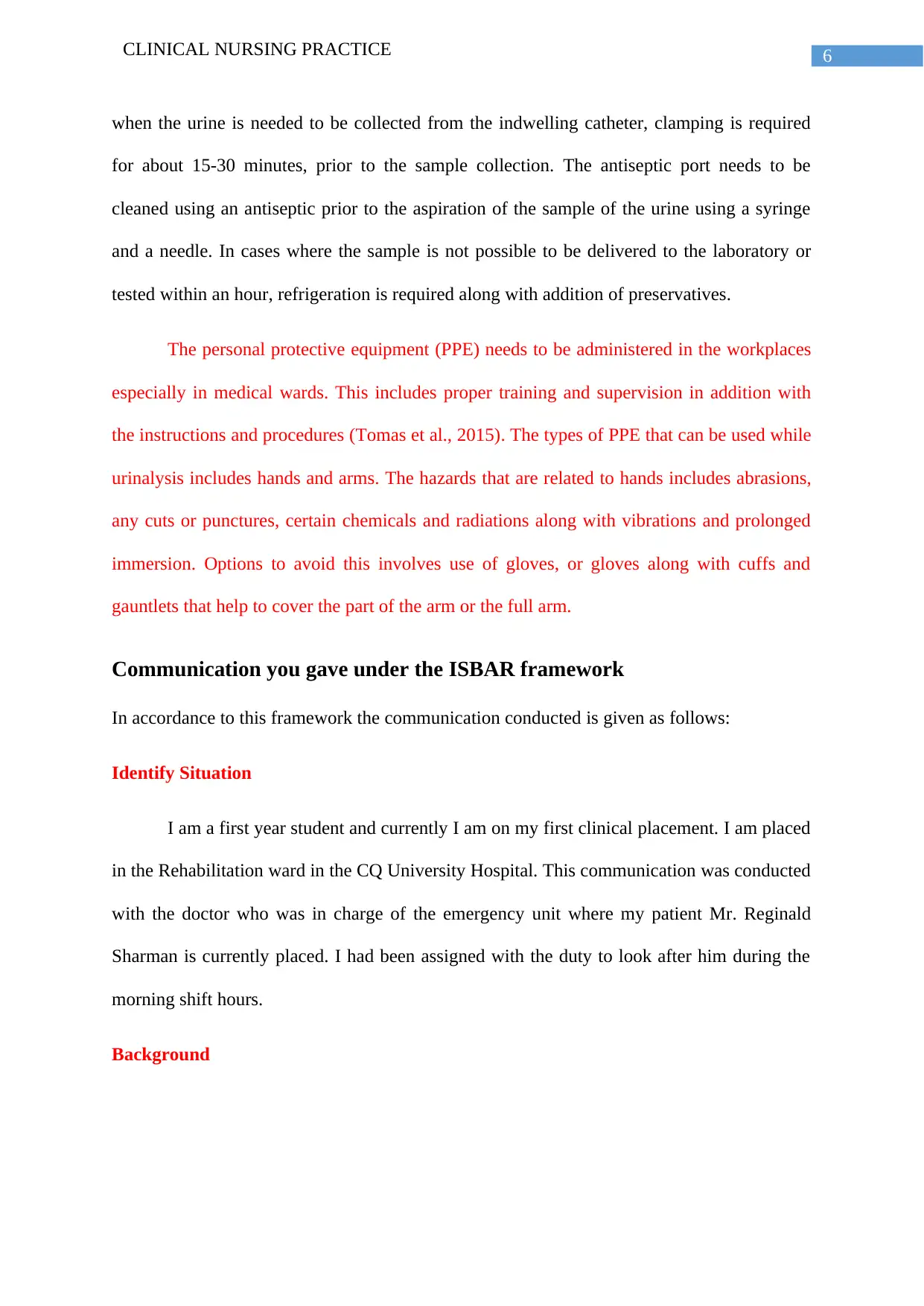
6CLINICAL NURSING PRACTICE
when the urine is needed to be collected from the indwelling catheter, clamping is required
for about 15-30 minutes, prior to the sample collection. The antiseptic port needs to be
cleaned using an antiseptic prior to the aspiration of the sample of the urine using a syringe
and a needle. In cases where the sample is not possible to be delivered to the laboratory or
tested within an hour, refrigeration is required along with addition of preservatives.
The personal protective equipment (PPE) needs to be administered in the workplaces
especially in medical wards. This includes proper training and supervision in addition with
the instructions and procedures (Tomas et al., 2015). The types of PPE that can be used while
urinalysis includes hands and arms. The hazards that are related to hands includes abrasions,
any cuts or punctures, certain chemicals and radiations along with vibrations and prolonged
immersion. Options to avoid this involves use of gloves, or gloves along with cuffs and
gauntlets that help to cover the part of the arm or the full arm.
Communication you gave under the ISBAR framework
In accordance to this framework the communication conducted is given as follows:
Identify Situation
I am a first year student and currently I am on my first clinical placement. I am placed
in the Rehabilitation ward in the CQ University Hospital. This communication was conducted
with the doctor who was in charge of the emergency unit where my patient Mr. Reginald
Sharman is currently placed. I had been assigned with the duty to look after him during the
morning shift hours.
Background
when the urine is needed to be collected from the indwelling catheter, clamping is required
for about 15-30 minutes, prior to the sample collection. The antiseptic port needs to be
cleaned using an antiseptic prior to the aspiration of the sample of the urine using a syringe
and a needle. In cases where the sample is not possible to be delivered to the laboratory or
tested within an hour, refrigeration is required along with addition of preservatives.
The personal protective equipment (PPE) needs to be administered in the workplaces
especially in medical wards. This includes proper training and supervision in addition with
the instructions and procedures (Tomas et al., 2015). The types of PPE that can be used while
urinalysis includes hands and arms. The hazards that are related to hands includes abrasions,
any cuts or punctures, certain chemicals and radiations along with vibrations and prolonged
immersion. Options to avoid this involves use of gloves, or gloves along with cuffs and
gauntlets that help to cover the part of the arm or the full arm.
Communication you gave under the ISBAR framework
In accordance to this framework the communication conducted is given as follows:
Identify Situation
I am a first year student and currently I am on my first clinical placement. I am placed
in the Rehabilitation ward in the CQ University Hospital. This communication was conducted
with the doctor who was in charge of the emergency unit where my patient Mr. Reginald
Sharman is currently placed. I had been assigned with the duty to look after him during the
morning shift hours.
Background
Paraphrase This Document
Need a fresh take? Get an instant paraphrase of this document with our AI Paraphraser
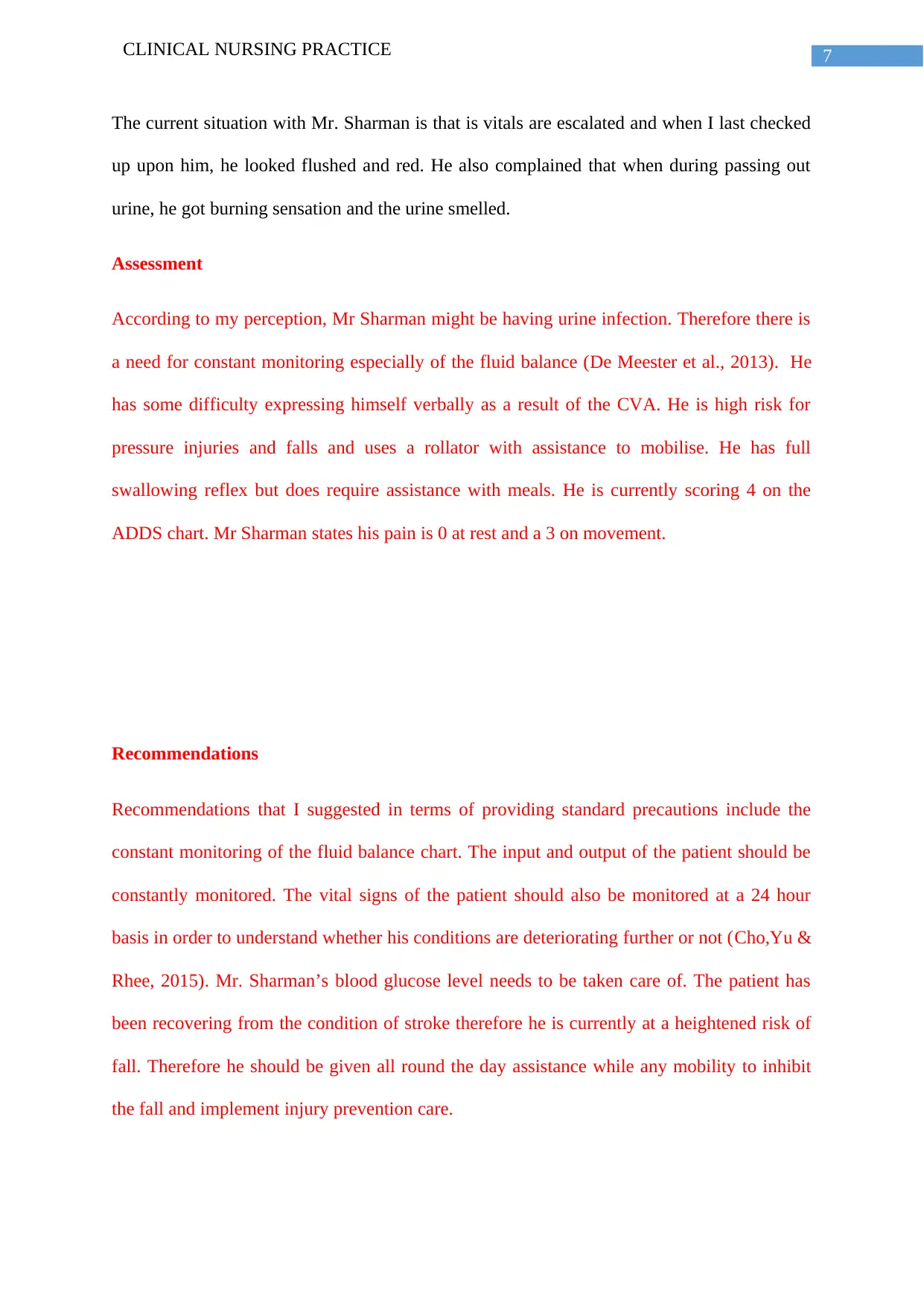
7CLINICAL NURSING PRACTICE
The current situation with Mr. Sharman is that is vitals are escalated and when I last checked
up upon him, he looked flushed and red. He also complained that when during passing out
urine, he got burning sensation and the urine smelled.
Assessment
According to my perception, Mr Sharman might be having urine infection. Therefore there is
a need for constant monitoring especially of the fluid balance (De Meester et al., 2013). He
has some difficulty expressing himself verbally as a result of the CVA. He is high risk for
pressure injuries and falls and uses a rollator with assistance to mobilise. He has full
swallowing reflex but does require assistance with meals. He is currently scoring 4 on the
ADDS chart. Mr Sharman states his pain is 0 at rest and a 3 on movement.
Recommendations
Recommendations that I suggested in terms of providing standard precautions include the
constant monitoring of the fluid balance chart. The input and output of the patient should be
constantly monitored. The vital signs of the patient should also be monitored at a 24 hour
basis in order to understand whether his conditions are deteriorating further or not (Cho,Yu &
Rhee, 2015). Mr. Sharman’s blood glucose level needs to be taken care of. The patient has
been recovering from the condition of stroke therefore he is currently at a heightened risk of
fall. Therefore he should be given all round the day assistance while any mobility to inhibit
the fall and implement injury prevention care.
The current situation with Mr. Sharman is that is vitals are escalated and when I last checked
up upon him, he looked flushed and red. He also complained that when during passing out
urine, he got burning sensation and the urine smelled.
Assessment
According to my perception, Mr Sharman might be having urine infection. Therefore there is
a need for constant monitoring especially of the fluid balance (De Meester et al., 2013). He
has some difficulty expressing himself verbally as a result of the CVA. He is high risk for
pressure injuries and falls and uses a rollator with assistance to mobilise. He has full
swallowing reflex but does require assistance with meals. He is currently scoring 4 on the
ADDS chart. Mr Sharman states his pain is 0 at rest and a 3 on movement.
Recommendations
Recommendations that I suggested in terms of providing standard precautions include the
constant monitoring of the fluid balance chart. The input and output of the patient should be
constantly monitored. The vital signs of the patient should also be monitored at a 24 hour
basis in order to understand whether his conditions are deteriorating further or not (Cho,Yu &
Rhee, 2015). Mr. Sharman’s blood glucose level needs to be taken care of. The patient has
been recovering from the condition of stroke therefore he is currently at a heightened risk of
fall. Therefore he should be given all round the day assistance while any mobility to inhibit
the fall and implement injury prevention care.
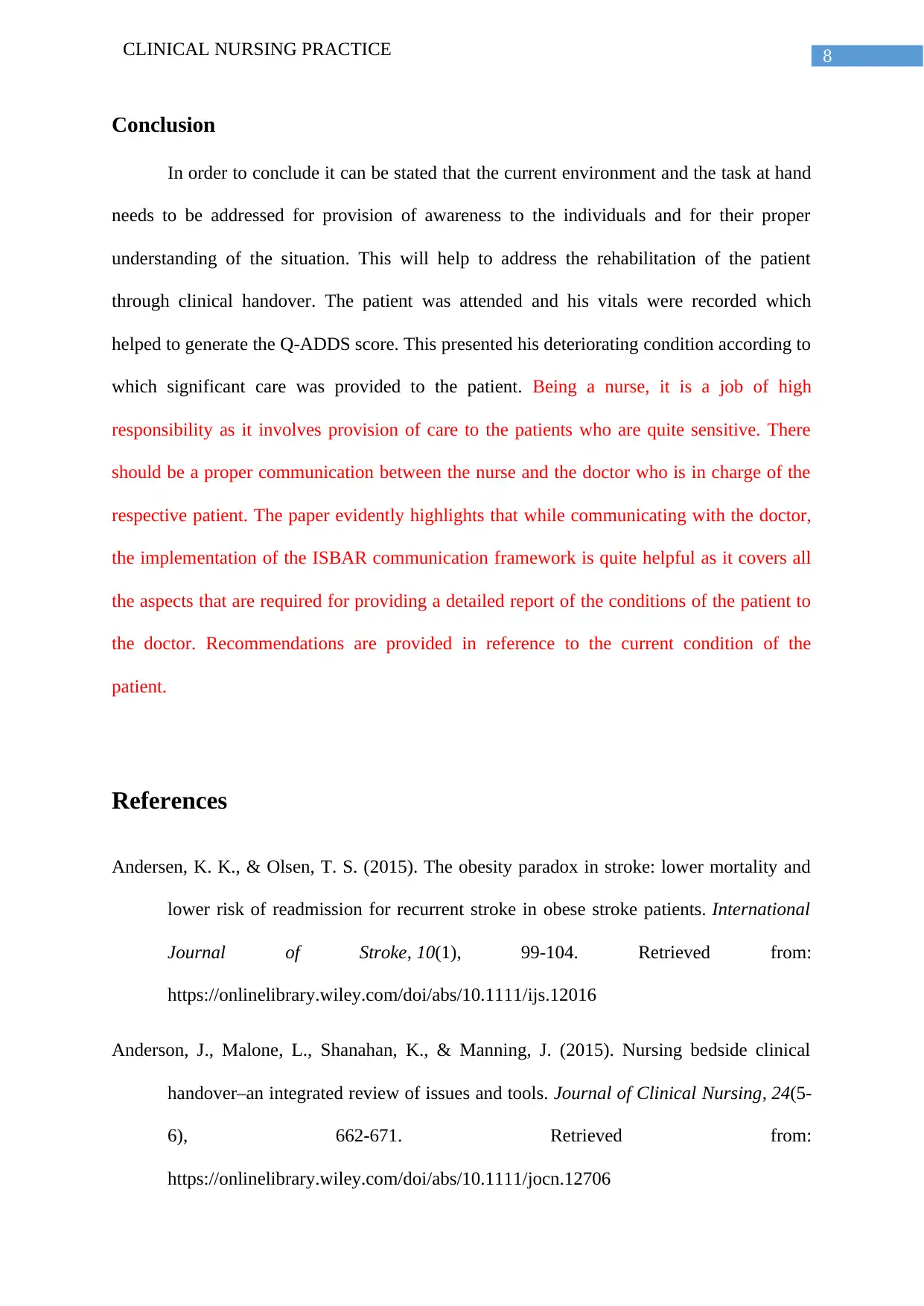
8CLINICAL NURSING PRACTICE
Conclusion
In order to conclude it can be stated that the current environment and the task at hand
needs to be addressed for provision of awareness to the individuals and for their proper
understanding of the situation. This will help to address the rehabilitation of the patient
through clinical handover. The patient was attended and his vitals were recorded which
helped to generate the Q-ADDS score. This presented his deteriorating condition according to
which significant care was provided to the patient. Being a nurse, it is a job of high
responsibility as it involves provision of care to the patients who are quite sensitive. There
should be a proper communication between the nurse and the doctor who is in charge of the
respective patient. The paper evidently highlights that while communicating with the doctor,
the implementation of the ISBAR communication framework is quite helpful as it covers all
the aspects that are required for providing a detailed report of the conditions of the patient to
the doctor. Recommendations are provided in reference to the current condition of the
patient.
References
Andersen, K. K., & Olsen, T. S. (2015). The obesity paradox in stroke: lower mortality and
lower risk of readmission for recurrent stroke in obese stroke patients. International
Journal of Stroke, 10(1), 99-104. Retrieved from:
https://onlinelibrary.wiley.com/doi/abs/10.1111/ijs.12016
Anderson, J., Malone, L., Shanahan, K., & Manning, J. (2015). Nursing bedside clinical
handover–an integrated review of issues and tools. Journal of Clinical Nursing, 24(5-
6), 662-671. Retrieved from:
https://onlinelibrary.wiley.com/doi/abs/10.1111/jocn.12706
Conclusion
In order to conclude it can be stated that the current environment and the task at hand
needs to be addressed for provision of awareness to the individuals and for their proper
understanding of the situation. This will help to address the rehabilitation of the patient
through clinical handover. The patient was attended and his vitals were recorded which
helped to generate the Q-ADDS score. This presented his deteriorating condition according to
which significant care was provided to the patient. Being a nurse, it is a job of high
responsibility as it involves provision of care to the patients who are quite sensitive. There
should be a proper communication between the nurse and the doctor who is in charge of the
respective patient. The paper evidently highlights that while communicating with the doctor,
the implementation of the ISBAR communication framework is quite helpful as it covers all
the aspects that are required for providing a detailed report of the conditions of the patient to
the doctor. Recommendations are provided in reference to the current condition of the
patient.
References
Andersen, K. K., & Olsen, T. S. (2015). The obesity paradox in stroke: lower mortality and
lower risk of readmission for recurrent stroke in obese stroke patients. International
Journal of Stroke, 10(1), 99-104. Retrieved from:
https://onlinelibrary.wiley.com/doi/abs/10.1111/ijs.12016
Anderson, J., Malone, L., Shanahan, K., & Manning, J. (2015). Nursing bedside clinical
handover–an integrated review of issues and tools. Journal of Clinical Nursing, 24(5-
6), 662-671. Retrieved from:
https://onlinelibrary.wiley.com/doi/abs/10.1111/jocn.12706
⊘ This is a preview!⊘
Do you want full access?
Subscribe today to unlock all pages.

Trusted by 1+ million students worldwide
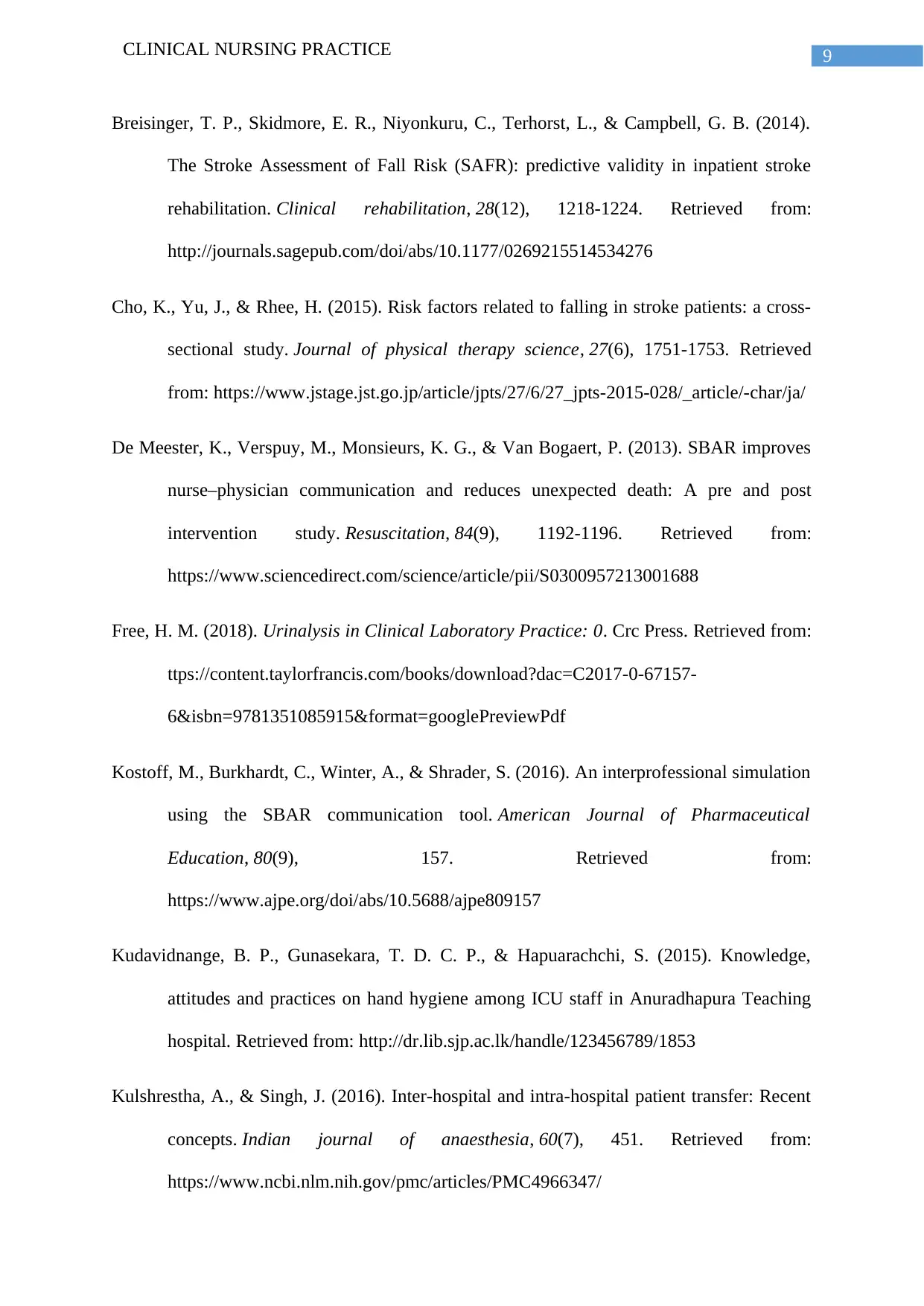
9CLINICAL NURSING PRACTICE
Breisinger, T. P., Skidmore, E. R., Niyonkuru, C., Terhorst, L., & Campbell, G. B. (2014).
The Stroke Assessment of Fall Risk (SAFR): predictive validity in inpatient stroke
rehabilitation. Clinical rehabilitation, 28(12), 1218-1224. Retrieved from:
http://journals.sagepub.com/doi/abs/10.1177/0269215514534276
Cho, K., Yu, J., & Rhee, H. (2015). Risk factors related to falling in stroke patients: a cross-
sectional study. Journal of physical therapy science, 27(6), 1751-1753. Retrieved
from: https://www.jstage.jst.go.jp/article/jpts/27/6/27_jpts-2015-028/_article/-char/ja/
De Meester, K., Verspuy, M., Monsieurs, K. G., & Van Bogaert, P. (2013). SBAR improves
nurse–physician communication and reduces unexpected death: A pre and post
intervention study. Resuscitation, 84(9), 1192-1196. Retrieved from:
https://www.sciencedirect.com/science/article/pii/S0300957213001688
Free, H. M. (2018). Urinalysis in Clinical Laboratory Practice: 0. Crc Press. Retrieved from:
ttps://content.taylorfrancis.com/books/download?dac=C2017-0-67157-
6&isbn=9781351085915&format=googlePreviewPdf
Kostoff, M., Burkhardt, C., Winter, A., & Shrader, S. (2016). An interprofessional simulation
using the SBAR communication tool. American Journal of Pharmaceutical
Education, 80(9), 157. Retrieved from:
https://www.ajpe.org/doi/abs/10.5688/ajpe809157
Kudavidnange, B. P., Gunasekara, T. D. C. P., & Hapuarachchi, S. (2015). Knowledge,
attitudes and practices on hand hygiene among ICU staff in Anuradhapura Teaching
hospital. Retrieved from: http://dr.lib.sjp.ac.lk/handle/123456789/1853
Kulshrestha, A., & Singh, J. (2016). Inter-hospital and intra-hospital patient transfer: Recent
concepts. Indian journal of anaesthesia, 60(7), 451. Retrieved from:
https://www.ncbi.nlm.nih.gov/pmc/articles/PMC4966347/
Breisinger, T. P., Skidmore, E. R., Niyonkuru, C., Terhorst, L., & Campbell, G. B. (2014).
The Stroke Assessment of Fall Risk (SAFR): predictive validity in inpatient stroke
rehabilitation. Clinical rehabilitation, 28(12), 1218-1224. Retrieved from:
http://journals.sagepub.com/doi/abs/10.1177/0269215514534276
Cho, K., Yu, J., & Rhee, H. (2015). Risk factors related to falling in stroke patients: a cross-
sectional study. Journal of physical therapy science, 27(6), 1751-1753. Retrieved
from: https://www.jstage.jst.go.jp/article/jpts/27/6/27_jpts-2015-028/_article/-char/ja/
De Meester, K., Verspuy, M., Monsieurs, K. G., & Van Bogaert, P. (2013). SBAR improves
nurse–physician communication and reduces unexpected death: A pre and post
intervention study. Resuscitation, 84(9), 1192-1196. Retrieved from:
https://www.sciencedirect.com/science/article/pii/S0300957213001688
Free, H. M. (2018). Urinalysis in Clinical Laboratory Practice: 0. Crc Press. Retrieved from:
ttps://content.taylorfrancis.com/books/download?dac=C2017-0-67157-
6&isbn=9781351085915&format=googlePreviewPdf
Kostoff, M., Burkhardt, C., Winter, A., & Shrader, S. (2016). An interprofessional simulation
using the SBAR communication tool. American Journal of Pharmaceutical
Education, 80(9), 157. Retrieved from:
https://www.ajpe.org/doi/abs/10.5688/ajpe809157
Kudavidnange, B. P., Gunasekara, T. D. C. P., & Hapuarachchi, S. (2015). Knowledge,
attitudes and practices on hand hygiene among ICU staff in Anuradhapura Teaching
hospital. Retrieved from: http://dr.lib.sjp.ac.lk/handle/123456789/1853
Kulshrestha, A., & Singh, J. (2016). Inter-hospital and intra-hospital patient transfer: Recent
concepts. Indian journal of anaesthesia, 60(7), 451. Retrieved from:
https://www.ncbi.nlm.nih.gov/pmc/articles/PMC4966347/
Paraphrase This Document
Need a fresh take? Get an instant paraphrase of this document with our AI Paraphraser
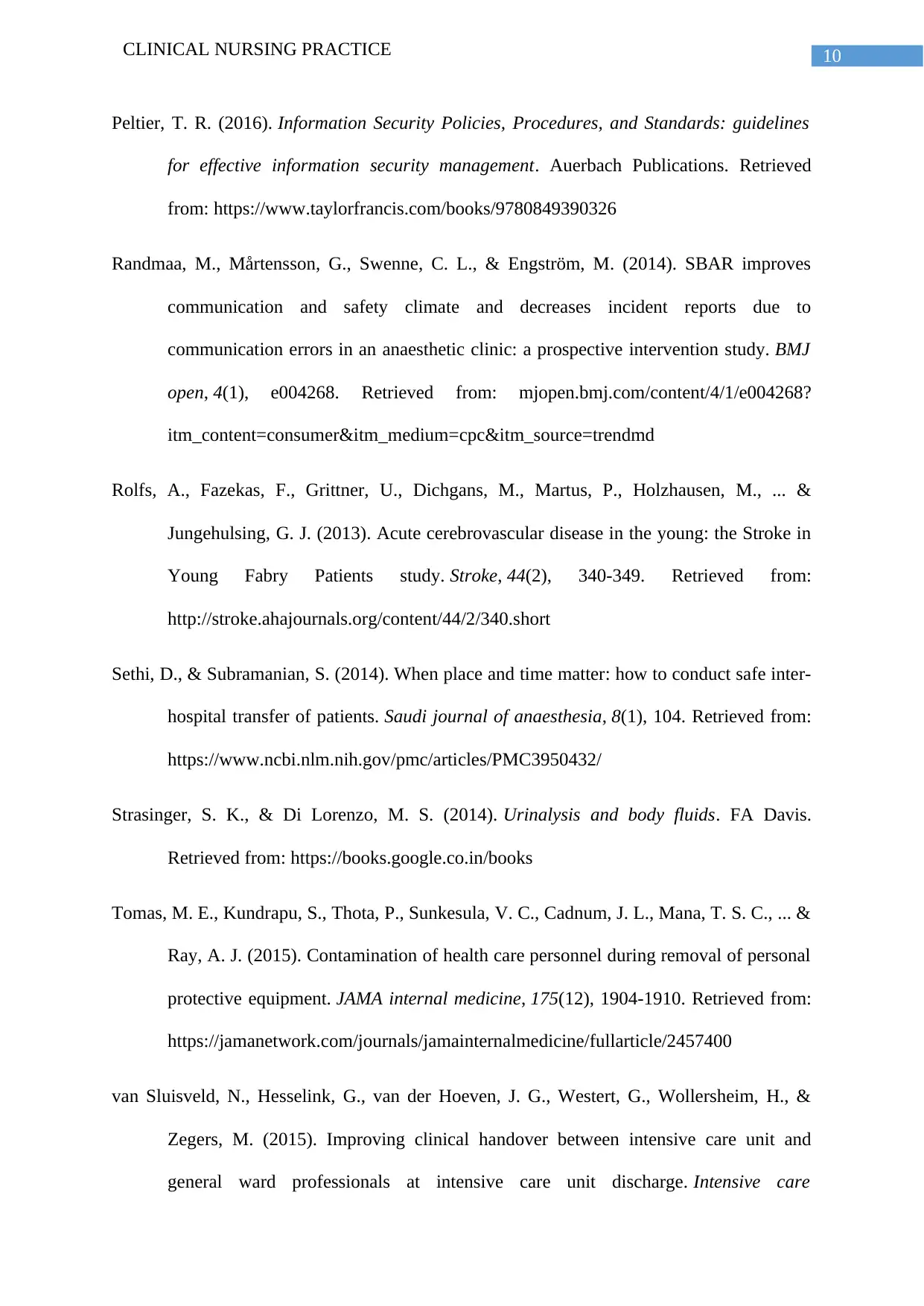
10CLINICAL NURSING PRACTICE
Peltier, T. R. (2016). Information Security Policies, Procedures, and Standards: guidelines
for effective information security management. Auerbach Publications. Retrieved
from: https://www.taylorfrancis.com/books/9780849390326
Randmaa, M., Mårtensson, G., Swenne, C. L., & Engström, M. (2014). SBAR improves
communication and safety climate and decreases incident reports due to
communication errors in an anaesthetic clinic: a prospective intervention study. BMJ
open, 4(1), e004268. Retrieved from: mjopen.bmj.com/content/4/1/e004268?
itm_content=consumer&itm_medium=cpc&itm_source=trendmd
Rolfs, A., Fazekas, F., Grittner, U., Dichgans, M., Martus, P., Holzhausen, M., ... &
Jungehulsing, G. J. (2013). Acute cerebrovascular disease in the young: the Stroke in
Young Fabry Patients study. Stroke, 44(2), 340-349. Retrieved from:
http://stroke.ahajournals.org/content/44/2/340.short
Sethi, D., & Subramanian, S. (2014). When place and time matter: how to conduct safe inter-
hospital transfer of patients. Saudi journal of anaesthesia, 8(1), 104. Retrieved from:
https://www.ncbi.nlm.nih.gov/pmc/articles/PMC3950432/
Strasinger, S. K., & Di Lorenzo, M. S. (2014). Urinalysis and body fluids. FA Davis.
Retrieved from: https://books.google.co.in/books
Tomas, M. E., Kundrapu, S., Thota, P., Sunkesula, V. C., Cadnum, J. L., Mana, T. S. C., ... &
Ray, A. J. (2015). Contamination of health care personnel during removal of personal
protective equipment. JAMA internal medicine, 175(12), 1904-1910. Retrieved from:
https://jamanetwork.com/journals/jamainternalmedicine/fullarticle/2457400
van Sluisveld, N., Hesselink, G., van der Hoeven, J. G., Westert, G., Wollersheim, H., &
Zegers, M. (2015). Improving clinical handover between intensive care unit and
general ward professionals at intensive care unit discharge. Intensive care
Peltier, T. R. (2016). Information Security Policies, Procedures, and Standards: guidelines
for effective information security management. Auerbach Publications. Retrieved
from: https://www.taylorfrancis.com/books/9780849390326
Randmaa, M., Mårtensson, G., Swenne, C. L., & Engström, M. (2014). SBAR improves
communication and safety climate and decreases incident reports due to
communication errors in an anaesthetic clinic: a prospective intervention study. BMJ
open, 4(1), e004268. Retrieved from: mjopen.bmj.com/content/4/1/e004268?
itm_content=consumer&itm_medium=cpc&itm_source=trendmd
Rolfs, A., Fazekas, F., Grittner, U., Dichgans, M., Martus, P., Holzhausen, M., ... &
Jungehulsing, G. J. (2013). Acute cerebrovascular disease in the young: the Stroke in
Young Fabry Patients study. Stroke, 44(2), 340-349. Retrieved from:
http://stroke.ahajournals.org/content/44/2/340.short
Sethi, D., & Subramanian, S. (2014). When place and time matter: how to conduct safe inter-
hospital transfer of patients. Saudi journal of anaesthesia, 8(1), 104. Retrieved from:
https://www.ncbi.nlm.nih.gov/pmc/articles/PMC3950432/
Strasinger, S. K., & Di Lorenzo, M. S. (2014). Urinalysis and body fluids. FA Davis.
Retrieved from: https://books.google.co.in/books
Tomas, M. E., Kundrapu, S., Thota, P., Sunkesula, V. C., Cadnum, J. L., Mana, T. S. C., ... &
Ray, A. J. (2015). Contamination of health care personnel during removal of personal
protective equipment. JAMA internal medicine, 175(12), 1904-1910. Retrieved from:
https://jamanetwork.com/journals/jamainternalmedicine/fullarticle/2457400
van Sluisveld, N., Hesselink, G., van der Hoeven, J. G., Westert, G., Wollersheim, H., &
Zegers, M. (2015). Improving clinical handover between intensive care unit and
general ward professionals at intensive care unit discharge. Intensive care
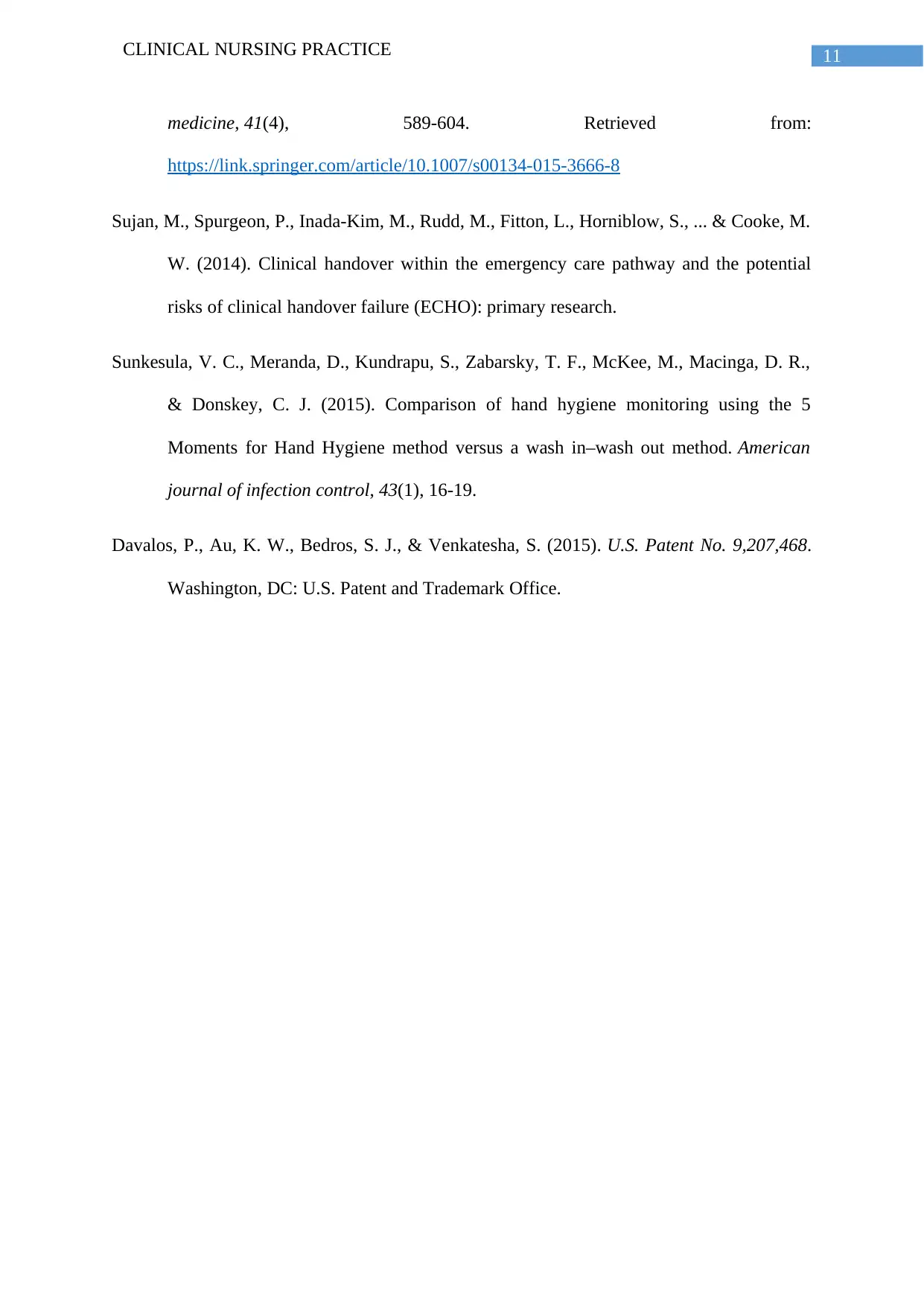
11CLINICAL NURSING PRACTICE
medicine, 41(4), 589-604. Retrieved from:
https://link.springer.com/article/10.1007/s00134-015-3666-8
Sujan, M., Spurgeon, P., Inada-Kim, M., Rudd, M., Fitton, L., Horniblow, S., ... & Cooke, M.
W. (2014). Clinical handover within the emergency care pathway and the potential
risks of clinical handover failure (ECHO): primary research.
Sunkesula, V. C., Meranda, D., Kundrapu, S., Zabarsky, T. F., McKee, M., Macinga, D. R.,
& Donskey, C. J. (2015). Comparison of hand hygiene monitoring using the 5
Moments for Hand Hygiene method versus a wash in–wash out method. American
journal of infection control, 43(1), 16-19.
Davalos, P., Au, K. W., Bedros, S. J., & Venkatesha, S. (2015). U.S. Patent No. 9,207,468.
Washington, DC: U.S. Patent and Trademark Office.
medicine, 41(4), 589-604. Retrieved from:
https://link.springer.com/article/10.1007/s00134-015-3666-8
Sujan, M., Spurgeon, P., Inada-Kim, M., Rudd, M., Fitton, L., Horniblow, S., ... & Cooke, M.
W. (2014). Clinical handover within the emergency care pathway and the potential
risks of clinical handover failure (ECHO): primary research.
Sunkesula, V. C., Meranda, D., Kundrapu, S., Zabarsky, T. F., McKee, M., Macinga, D. R.,
& Donskey, C. J. (2015). Comparison of hand hygiene monitoring using the 5
Moments for Hand Hygiene method versus a wash in–wash out method. American
journal of infection control, 43(1), 16-19.
Davalos, P., Au, K. W., Bedros, S. J., & Venkatesha, S. (2015). U.S. Patent No. 9,207,468.
Washington, DC: U.S. Patent and Trademark Office.
⊘ This is a preview!⊘
Do you want full access?
Subscribe today to unlock all pages.

Trusted by 1+ million students worldwide
1 out of 16
Related Documents
Your All-in-One AI-Powered Toolkit for Academic Success.
+13062052269
info@desklib.com
Available 24*7 on WhatsApp / Email
![[object Object]](/_next/static/media/star-bottom.7253800d.svg)
Unlock your academic potential
Copyright © 2020–2025 A2Z Services. All Rights Reserved. Developed and managed by ZUCOL.





